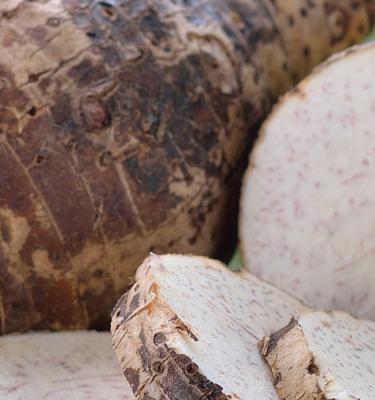

The Ultimate Guide to Growing Taro
Taro is a staple crop in many pacific countries that produces an edible white tuber beneath the ground. The starchy taro root can be boiled, baked, steamed or fried - taro chips are particularly delicious!
Above ground - the taro plant produces deep green, heart-shaped leaves. Taro is best grown in warm seasons when temperatures are above 25 degrees and there is zero risk of frost.
Taro needs consistent watering and well-drained but rich soil to thrive (the plants will tolerate waterlogged soils for short periods of time). Taro is ready to harvest 7-12 months after planting (depending on the variety) when the leaves begin to yellow and die back. Harvest taro by digging up the tubers using a garden fork. Taro root won’t store for longer than a month, they are best eaten fresh and must be cooked before consuming to avoid stomach aches. Young taro leaves can also be harvested and cooked before eating.
5 top tips for growing taro
- Taro prefers a part-shade spot, protected from the hottest afternoon sun. Some varieties will tolerate a full sun position, particularly in tropical climates - check the labels of your variety before planting your taro plant.
- Improve the soil before planting your taro plant by adding plenty of compost or Scotts Performance Natural Organic Based Soil Improver.
- Taro plants can be grown from roots from the grocery store or potted plants, whichever is more readily available to you.
- Harvest taro 7-12 months after planting, depending on the variety. Temperate climate gardeners should choose varieties that will crop quickly before frost arrives.
- Taro is relatively pest and disease free, however it will need regular and consistent watering
Essential shopping list for growing taro
- Taro roots or potted plants
- Scotts Performance Natural Organic Based Soil Improver
- Scotts Performance Natural All Purpose Organic Based Fertiliser
- If growing in pots, Scotts Performance Naturals Premium Potting Mix and a suitable pot
- Garden trowel
- Mulch
Prepare
Choose a part shade or full sun position (depending on the variety you’ve chosen). If you live in a hot, dry climate taro will prefer a part shade position protected from the extremely hot afternoon sun.
Enriched the soil before planting taro by mixing Scotts Performance Natural Organic Based Soil Improver and a Scotts Performance Natural All Purpose Organic Based Fertiliser through the top 20-30cm of soil.
Planting taro in the garden
Taro can be grown in free-draining, well prepared soil. Although it will also tolerate waterlogged soils for short periods of time.
Plant taro root pieces or potted plants 80-100cm apart into your prepared soil. If planting leafless root pieces ensure they are planted around 5cm deep. Water in your new taro well and keep well watered throughout the growing season.
Mulch around your taro plants to suppress weeds and retain moisture. Fertilise with a light sprinkle of Scotts Performance Natural All Purpose Organic Based Fertiliser around each taro plant 6-8 weeks after planting.
Planting taro in pots
Taro can be grown in large pots 50-60cm deep by the same width. A half wine barrel with added drainage holes is the ideal size for 1 plant.
Fill the pot with Scotts Performance Naturals Premium Potting Mix and plant your taro into the centre of the potting mix. Position your pot in a full sun or part shade spot (depending on the variety of taro you’ve chosen).
Fertilise with a light sprinkle of Scotts Performance Natural All Purpose Organic Based Fertiliser on the potting mix surface 6-8 weeks after planting.
Regular watering of taro is critical during the warmer months, it will quickly become heat stressed and produce less tubers if left to dry out. Mulch the top of your potting mix around the taro plant to suppress weeds and retain moisture.
When to harvest taro
Depending on the variety you’ve chosen, taro will be ready to harvest 7-12 months after planting. You’ll notice the leaves of the taro plant begin to yellow and die back as harvest time arrives.
Carefully dig up the tubers and store for no longer than a month before cooking and eating. Tubers MUST be cooked before eating, they can be boiled, steamed, baked or fried.
Common taro pests and diseases
Taro is relatively pest and disease free.



